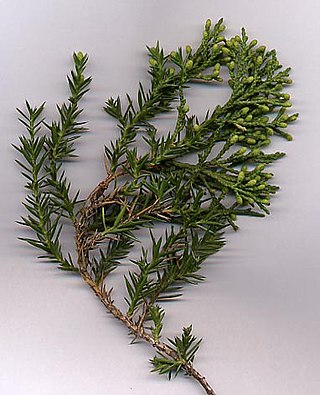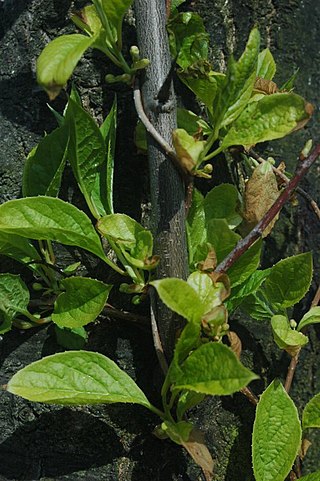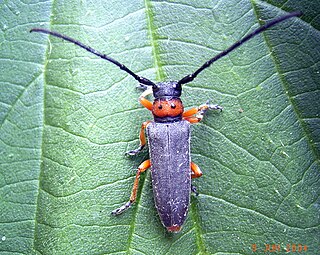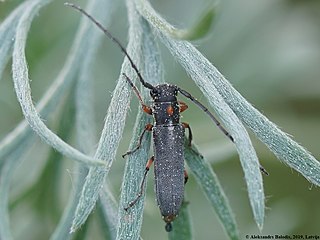
Lychee is a monotypic taxon and the sole member in the genus Litchi in the soapberry family, Sapindaceae.

Simmondsiaceae or the jojoba family is a family of flowering plants. The family is not recognized by all taxonomic systems, the single species, Simmondsia chinensis, often being treated as belonging to family Buxaceae.

The spotted dove or eastern spotted dove is a small and somewhat long-tailed pigeon that is a common resident breeding bird across its native range on the Indian subcontinent and in East and Southeast Asia. The species has been introduced to many parts of the world and feral populations have become established.

Juniperus chinensis, the Chinese juniper, is a species of plant in the cypress family Cupressaceae, native to China, Myanmar, Japan, Korea and the Russian Far East. Growing 1–20 metres tall, it is a very variable coniferous evergreen tree or shrub.

Schisandra chinensis, whose fruit is called magnolia berry or five-flavor fruit, is a vine plant native to forests of Northern China, the Russian Far East and Korea. Wild varieties are also found in Japan. It is hardy in USDA Zone 4. The fruits are red berries in dense clusters around 10 centimetres (3.9 in) long.

Opsilia is a genus of beetles in the family Cerambycidae. It is listed as a subgenus of Phytoecia by some sources.

Phytoecia is a genus of longhorn beetles of the subfamily Lamiinae,
Phytoecia gianassoi is a species of beetle in the family Cerambycidae. It was described by Sama in 2007 and later reclassified to the subgenus Coptosia within the genus Phytoecia.

Phytoecia puncticollis is a species of beetle in the family Cerambycidae. It was described by Faldermann in 1837. It is known from Russia, Azerbaijan, Georgia, Iraq, Armenia, Turkey, Iran, and Turkmenistan. It feeds on Eryngium billardierei.
Phytoecia gaubilii is a species of beetle in the family Cerambycidae. It was described by Mulsant in 1851. It is known from Tunisia and Algeria.

Phytoecia comes is a species of beetle in the family Cerambycidae. It was described by Henry Walter Bates in 1884. It is known from Taiwan, Myanmar, North Korea, South Korea, China, Vietnam, and Japan.
Phytoecia humeralis is a species of beetle in the family Cerambycidae. It was described by Waltl in 1838, originally under the genus Saperda. It is known from Palestine, Greece, Georgia, Iran, Azerbaijan, Syria, Cyprus, and Turkey. It feeds on Silybum marianum.
Phytoecia millefolii is a species of beetle in the family Cerambycidae. It was described by Adams in 1817, originally under the genus Saperda. It has a wide distribution between Europe and the Middle East.

Phytoecia affinis is a species of beetle in the family Cerambycidae. It was described by Harrer in 1784, originally under the genus Leptura. It has a wide distribution in Europe.

Phytoecia caerulescens is a species of beetle in the family Cerambycidae. It was described by Scopoli in 1763, originally under the genus Leptura. It has a wide distribution in Europe, and has been introduced into Australia. It feeds on Echium vulgare, Lappula squarrosa, Anchusa officinalis, Lithospermum officinale, and Cynoglossum officinale.

Phytoecia caerulea is a species of beetle in the family Cerambycidae. It was described by Scopoli in 1772, originally under the genus Leptura. It has a wide distribution in Europe.

Phytoecia pustulata is a species of beetle in the family Cerambycidae. It was described by Schrank in 1776, originally under the genus Cerambyx. It has a wide distribution throughout Europe and the Middle East.

Phytoecia rufiventris is a species of beetle in the family Cerambycidae. It was described by Gautier des Cottes in 1870. It is known from Russia, Japan, Taiwan, Mongolia, North Korea, South Korea, China, and Vietnam. It feeds on Artemisia vulgaris.
Phytoecia tenuilinea is a species of beetle in the family Cerambycidae. It was described by Léon Fairmaire in 1877. It is known from Morocco and Algeria.
Phytoecia hirsutula is a species of beetle in the family Cerambycidae. It was described by Frölich in 1793, originally under the genus Saperda. It has a wide distribution between Europe and the Middle East.












